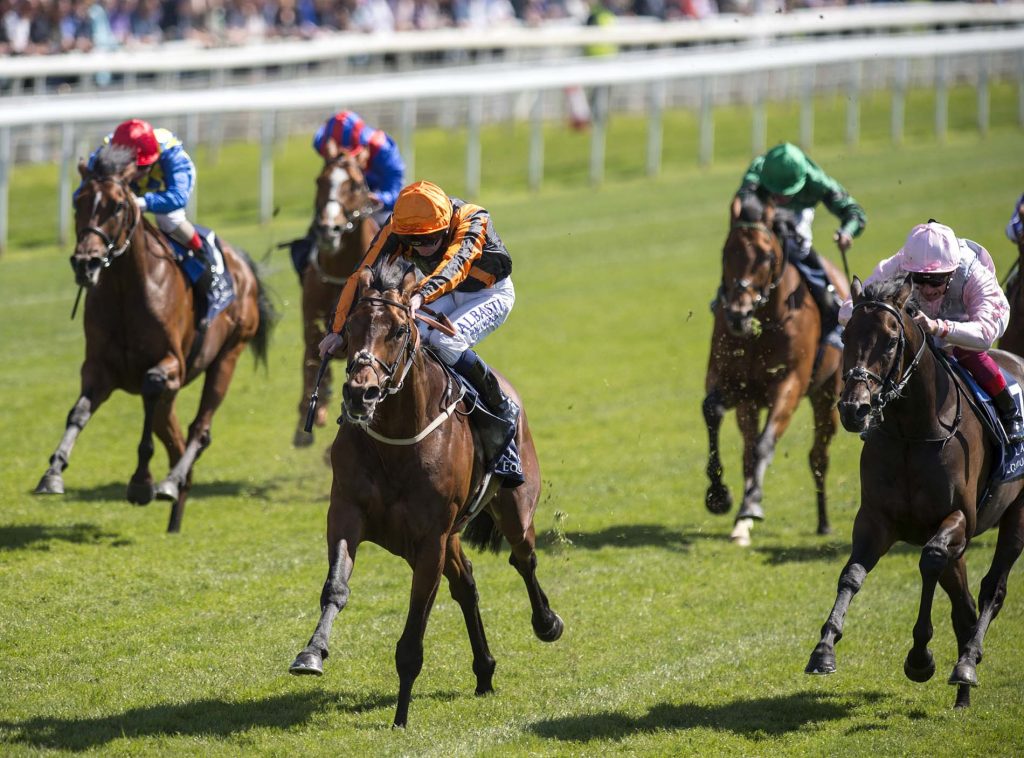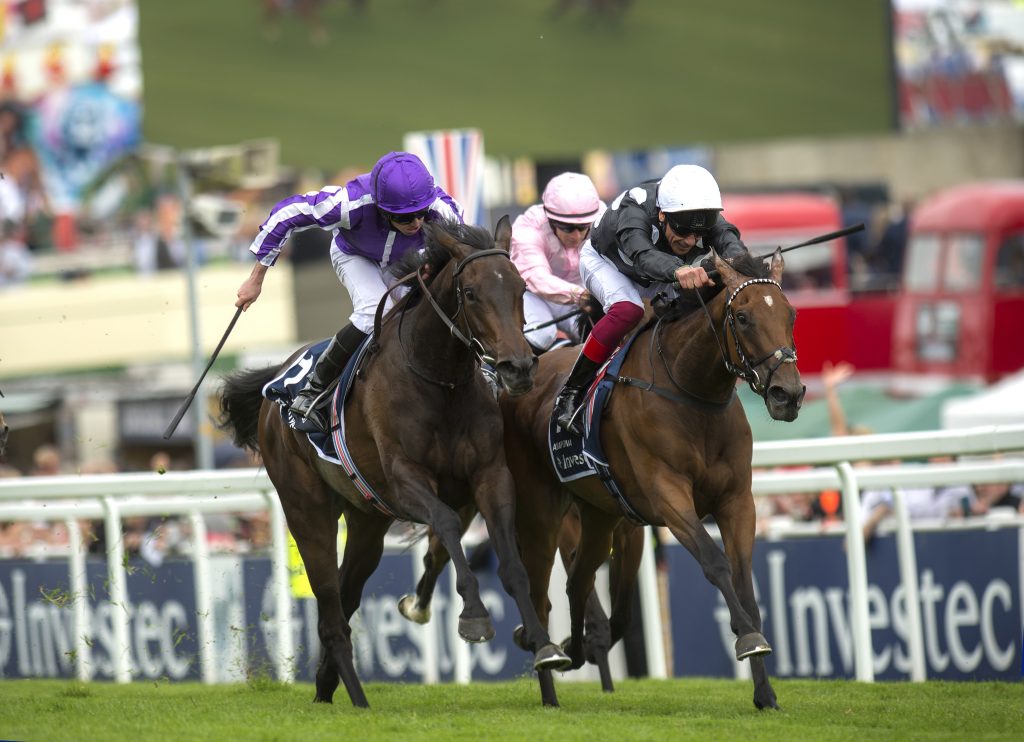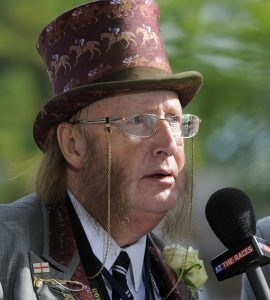There can be several twists and turns during the course of a horse race, as Mark Weinfeld and his sister Helena Ellingsen would readily attest. Brother and sister ran the entire gauntlet in a roller-coaster 24 hours that separated the Derby from the Oaks.
The whole world knows that the Weinfelds’ Meon Valley Stud bred Anapurna, who won the fillies’ Classic, and Telecaster, who was fancied for the Derby but ended up trailing back through the field. Neither of those outcomes looked likely when the two horses reached the bottom of Tattenham Corner in their respective races.
“Turning into the straight in the Derby I thought we had a chance of being in the first three,” Mark Weinfeld says of Telecaster, who was travelling strongly on the heels of the leaders. “But there was no petrol in the tank; it was disappointing.”
At the corresponding stage of the Oaks, by contrast, Anapurna was short of racing room. “I hoped we might be lucky enough to finish third,” Weinfeld relates. “But Frankie [Dettori] got a clear run and suddenly he burst through. We couldn’t believe it; we floated home that evening.”
The first British Classic winner by Frankel, Anapurna is a first British Classic winner in the family’s black and white-spotted livery since her fourth dam, One In A Million, landed the 1,000 Guineas 40 years earlier. A pleasing symmetry thus came to pass. One In A Million was among three yearling fillies bought by the Weinfelds’ late father, Egon, as potential foundation mares in 1977.
“We couldn’t believe it; we floated home that evening”
It’s the sort of continuity that has kept Meon Valley to the fore among Britain’s owner-breeders. Those three yearling fillies – Reprocolor and Odeon, in addition to One In A Million – were joined the following year by another, Home And Away. Remarkably, the blood of all four still courses through the vast majority of the 35-strong broodmare band today.
From them have spawned 20 individual Group 1 winners, which represents a strike-rate of one every two years. Many of them are racing royalty: the likes of Colorspin, Izzi Top, Lady Carla, Milligram, One So Wonderful, Opera House and the staying titans, Kayf Tara and San Sebastian. Telecaster’s Dante Stakes triumph also registered the 1,000th winner bred by the nursery that sits on the chalk downs of Hampshire.
All of which has put the stud in an enviable position. Meon Valley is perennially among the leading vendors at the Tattersalls Book 1 Yearling Sale. It will consign a herd of around 12 yearlings in October, but a closer look at its draft unveils a harsh truth.
The team will not include yearling siblings to either Anapurna or Telecaster. Nor are there foals from these mares grazing the paddocks. The dams in question, Dash To The Top and Shirocco Star respectively, have been beset by woes familiar to all breeders. There will be no sales payday from them in each of the next two years.
Part of the reason Anapurna was retained by the stud was that Dash To The Top, a Listed winner who was second in the Group 1 Yorkshire Oaks, has proved a difficult breeder. “Luca [Cumani, who trained Dash To The Top] always said she was a brilliant mare that we never saw the best of on the track,” Weinfeld, 64, says.
“She’s 17, so she is getting on a bit now. She is troubled by cysts, which we are going to try and treat this summer in the hope she can have one more go next year. She visited Muhaarar this time but no joy, I’m afraid.” It is the third successive year Dash To The Top has failed to conceive.

Telecaster (orange cap) gets the better of Too Darn Hot to land the Group 2 Dante Stakes – Photo: George Selwyn
Meanwhile, Telecaster’s dam Shirocco Star aborted to Frankel in 2018 before failing to catch when bred to Iffraaj later that year. “After that we had her cleaned up inside and have got her back in foal to Frankel,” Weinfeld relates.
A son of New Approach, Telecaster was offered at the 2017 yearling sales but failed to find a buyer. Meon Valley’s policy is to sell all the colts, yet despite his Derby lapse Telecaster is already the most successful colt to race for the Weinfelds through their Castle Down Racing partnership.
It was a similar story with Shirocco Star herself. A sixth-generation descendant of Reprocolor, she was sent to the yearling sales in 2010 but returned home despite a modest reserve. Yet this particular chapter also had a happy ending. As with Telecaster, who is now worth considerably more than his 200,000-guinea yearling reserve, a leg in Shirocco Star is worth far more than the 50,000-guinea reserve placed on her.
That much was a given after Shirocco Star finished runner-up in the Oaks and its Irish equivalent in 2012 when trained by Hughie Morrison. Her value will now have risen again: Telecaster is only her second foal.
Strange to relate, but a deal of Meon Valley’s success has emanated from horses that failed to sell. This serves to illustrate the fluctuations of fate’s fickle finger, which Weinfeld is quick to acknowledge has frequently pointed kindly in the stud’s direction.
“From our perspective, it’s important to have confidence in our stock”
Against that, Meon Valley’s philosophy has always been to breed racehorses first and foremost. It sells the vast majority of its produce because bills must be paid, but the fact that Weinfeld is prepared to put unsold horses into training makes an attractive statement.
“Perhaps a lot of our best horses came back to us because many of them are late maturing,” Weinfeld says. “They don’t look the part so much when they go to the sales. The fact Telecaster didn’t race at two bears that out.
“So many people want early-maturing two-year-olds that might win at Royal Ascot, and while they might also want to win the Derby, they aren’t necessarily prepared to buy a horse that’s bred to do it.
“It is not a very good year for us if we take home half a dozen from the sales,” he continues. “You could get a bit depressed if you were that way inclined, but we see it as another opportunity. We’re happy to put them into training.
“There’s a huge amount of satisfaction when it comes right and you get a good horse like Telecaster. It vindicates what we’re doing and shows that the industry was wrong to reject him.
“But this happens to a lot of other studs. From our perspective, it’s important to have confidence in our stock. We stand by them. After all, if you’re not prepared to buy back a horse at a reasonable price, then why would anybody else want to buy it?”

Anapurna (right) on her way to winning the Oaks at Epsom – Photo: George Selwyn
Following Anapurna’s Oaks triumph, and with Telecaster to come, Weinfeld was out of bed at 5am on Derby morning. “I was box-walking,” he recalls. “In the end we shouldn’t have gone to Epsom [Telecaster was supplemented five days before the race at a cost of £85,000], but it certainly made us proud to have won the Oaks and to have one of the Derby favourites.
“It would have been unbelievable to have won both races,” he continues. “I don’t think any British owner-breeder has ever won both of the Epsom Classics in the same year – certainly not in the 20th century. But for an outfit of our size, with around 25 foals on the ground each year, it was quite something.”
It’s hard to remember a time when Meon Valley endured a spell in the doldrums. Mention this to Weinfeld, however, and it prompts a wince. There are two facets in play here: the success of the stud’s graduates on the racecourse, and the prices fetched by yearlings at public auction. Weinfeld has experienced lulls in both, although needless to say, such ‘lulls’ are relative.
On the racing front, Weinfeld says: “It had gone a bit quiet for some years up to 2011, when [Gimcrack and Mill Reef Stakes winner] Caspar Netscher came along.
“Then we had Izzi Top and Jazzi Top, then Speedy Boarding who, like Anapurna, is from One In A Million’s family. It’s strange how some families can suddenly recycle and come back again.”
Weinfeld relates that the relative scarcity of Pattern-race triumphs over that period prompted some re-evaluation of Meon Valley’s methods, albeit subconsciously. “I suppose we did consider it,” he reflects. “You might look into what you’re feeding, your grazing regimes and grass management, but you’re always fine-tuning that anyway.
“We have had some really tough years where we’ve had to grin and bear it”
“Perhaps it was even down to the choice of stallions,” he continues. “You also have a few ideas about new things you might try, but there was no particular moment when we thought we’d make lots of changes. We always try and mate the best to the best and hope for the best. The best needn’t necessarily be the most expensive; it’s what’s best for the mare.”
The internal audit has to be more forensic where sales results are concerned. For all Meon Valley’s success, breeding horses is prohibitively expensive right across the scale, from stallion fees through to staff, equipment and state-of-the-art management techniques. Income streams are vital.
“The sales, like the business in general, can be a real roller-coaster,” Weinfeld avers. “We have had some really tough years where we’ve had to grin and bear it. We went through a period a few years ago when sales weren’t keeping up with the costs of running the stud.
“That makes you think about cutting the numbers back but that’s a tricky exercise. If you start thinking that way you’ll want to keep the best mares and send them to the best stallions, so you don’t actually reduce your costs that much.
“And just occasionally you might have an unraced mare with a nice pedigree and send her to a stallion who’s reasonably priced, and who subsequently comes good. All of a sudden that could be the horse which earns you a lot of money. Having these kind of horses in the pack can be quite useful.”
For most breeders, such a scenario would amount to an embarrassment of riches. For Meon Valley it has become almost par for the course.
‘Racehorses don’t drop out the sky’
John Gosden, who trains Anapurna, was doubly delighted to win the Oaks for the filly’s owner-breeders, Mark Weinfeld and Helena Ellingsen’s Meon Valley Stud. Together with his wife, Rachel Hood, Gosden knows the perils of breeding horses at first hand. He believes owner-breeders are the most underrated entity within racing and pays the following tribute.
“Mark and Helena well understand the vicissitudes involved in breeding horses. Getting a mare in foal, raising that foal and rearing it to the point where it can go into training is a feat in itself. It is such a labour of love and passion, but it’s also a very tough thing to do. There is a lack of public awareness of this, which is sad.
“It’s a most precarious pastime. Foals and yearlings can get injured, they can run into a fence, and the dream is dashed right there. If young horses survive that, breeders then send them to wicked people called trainers who undo half the good work they have already done, and then ring to say the horse is no good.
“A mistake the authorities make in all racing jurisdictions is that they think racehorses just drop out of the sky, ready to roll. It’s just not like that; it’s extremely difficult to get a horse to the top level, as Mark and Helena have done so consistently over the years.
“From an owner-breeder’s perspective, winning a race like the Oaks is extraordinarily special. The significance is profound; just getting a homebred horse to win any kind of race is an achievement in itself. So many things can go wrong.”
That latter point was emphasised back in January, when Meon Valley Stud’s Snazzi Top, a promising three-year-old daughter of Invincible Spirit and Group 1 winner Zee Zee Top, met with a tragic accident as she waited to join the rest of Gosden’s string at morning exercise.
“Something frightened her and she reared up, hit the wall of her box and that was that,” Gosden relates. “It was the sort of ill fate that comes out of the blue, and which owner-breeders have to contend with. Sometimes it can be such a cruel game.”



